Targeting the malignancy

IGRT (Image Guided Radiotherapy), with minimal radiation of surrounding structures under the guidance of real time imaging, has emerged as a high-end technique for treatment of prostate cancer…
By Dr Manish Pandey
Prostate cancer usually affects males in their 6th to 7th decade of life. It usually presents as difficulty in passing urine or frequent passage of urine and closely mimics benign prostatic hyperplasia in symptoms. It is highly recommended to consult a urologist if these symptoms occur.

The main treatment of prostate cancer is radiotherapy except in early stages where surgical resection might be an option. Radiotherapy for prostate cancer has undergone a tremendous change from 3DCRT to IMRT to IGRT. IGRT is the most advanced technique for treating prostatic cancer which starts with preparation of immobilization cast and radiotherapy planning CT scan. Adequate radiotherapy planning requires the urinary bladder to be full and rectum to be emptied (without stools and gas).
 A contrasts enhanced CT scan is performed and then targets are drawn as per the stage of the patient. These basic steps remain same for all the techniques of radiotherapy but the difference lies in prescribing radiotherapy doses to the tumour and surrounding normal organs. IGRT (Image Guided Radiotherapy) refers to the treatment of prostate with minimal radiation of normal surrounding structures under the guidance of real time imaging.
A contrasts enhanced CT scan is performed and then targets are drawn as per the stage of the patient. These basic steps remain same for all the techniques of radiotherapy but the difference lies in prescribing radiotherapy doses to the tumour and surrounding normal organs. IGRT (Image Guided Radiotherapy) refers to the treatment of prostate with minimal radiation of normal surrounding structures under the guidance of real time imaging.
 A CT scan is attached to the treatment unit through which a scan is taken just before the actual treatment and is matched with the CT scan taken at the time of planning. Any changes are noted and corrected to ensure that the exact planned treatment is being delivered to the patient. It is a high-end technique of radiotherapy which needs qualified radiation oncologist, physicist and radiation technologists and an adequate treatment time on machine. Urinary bladder and rectum are the most important organ at risk during the radiation of prostate and IGRT helps in reducing toxicity to both the organs by keeping a check on their filling (bladder full, rectum empty) with the scan taken immediately before treatment.
A CT scan is attached to the treatment unit through which a scan is taken just before the actual treatment and is matched with the CT scan taken at the time of planning. Any changes are noted and corrected to ensure that the exact planned treatment is being delivered to the patient. It is a high-end technique of radiotherapy which needs qualified radiation oncologist, physicist and radiation technologists and an adequate treatment time on machine. Urinary bladder and rectum are the most important organ at risk during the radiation of prostate and IGRT helps in reducing toxicity to both the organs by keeping a check on their filling (bladder full, rectum empty) with the scan taken immediately before treatment.
Another feature of IGRT is placement of radio-opaque markers (usually gold) in the prostate which are tracked real time during the treatment with the X-ray tracker placed in the treatment unit. It is usually practised in the treatment of early stage prostate cancer where the target is only prostate. At Sri Balaji Action Cancer Hospital, IGRT is regularly practised with significant results thanks to high-end linear accelerator and dedicated staff.
(The author is Senior Consultant, Radiation Oncology, Sri Balaji Action Cancer Hospital, New Delhi)

